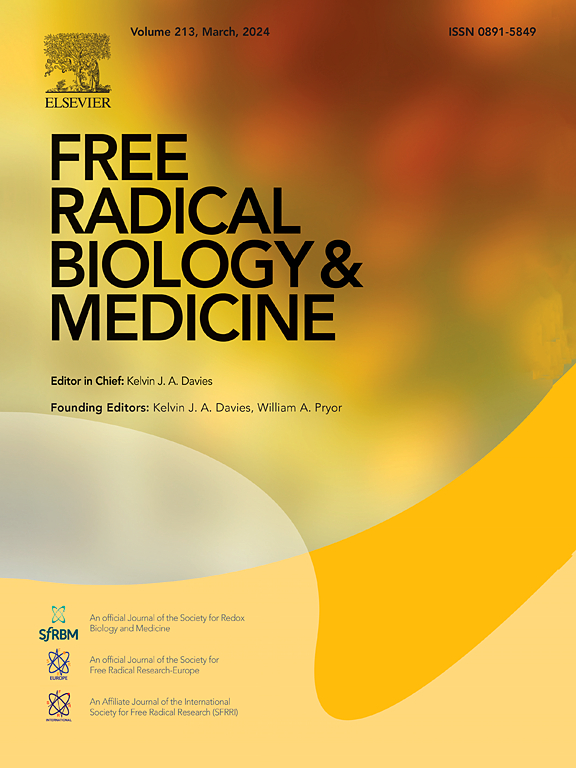GATAD1通过调节心肌脂肪酸氧化和葡萄糖氧化参与鞘氨酰基磷胆碱减薄的心肌缺血再灌注损伤。
IF 7.1
2区 生物学
Q1 BIOCHEMISTRY & MOLECULAR BIOLOGY
引用次数: 0
摘要
调节糖代谢和脂代谢之间的平衡是治疗心肌缺血/再灌注(I/R)损伤的极具前景的新策略。sphingosylphospylcholine (SPC)是鞘脂的中间代谢物,在心肌梗死期间通过调节多种转录因子的活性显示出心脏保护作用。基因芯片显示,SPC显著上调GATA锌指结构域蛋白1 (GATA zinc finger domain protein 1, GATAD1)的表达,GATA锌指结构域蛋白1是影响心脏发育和多种心脏病的重要转录因子。然而,目前尚不清楚SPC是否通过GATAD1参与心脏脂肪酸和葡萄糖代谢的调节。在本研究中,我们发现心肌特异性Gatad1敲除(Gatad1 CKO)显著增加I/R小鼠心肌梗死面积,心功能受损,并破坏SPC对I/R小鼠心脏的保护作用。核细胞质分离样品的免疫荧光实验和western blot评价表明,GATAD1作为转录因子,受SPC调控。双荧光报告实验和定量聚合酶链反应(qPCR)显示GATAD1能抑制脂肪酸氧化(FAO)相关基因乙酰辅酶A酰基转移酶2 (Acaa2)和中链酰基辅酶A脱氢酶(Acadm)的表达,促进葡萄糖氧化相关基因丙酮酸脱氢酶E1 α亚基(Pdha1)的表达。小干扰RNA (SiRNA)或过表达策略证实了在I/R处理心肌细胞中Acaa2和Acadm的促凋亡作用和Pdha1的抗凋亡作用。总之,我们的研究结果表明,SPC可以作为通过重塑脂肪酸和葡萄糖代谢来预防I/R损伤的候选药物。转录因子GATAD1在调节脂肪酸氧化和葡萄糖氧化稳态中起关键作用,并参与心脏I/R过程中spc介导的心脏保护。本研究确定GATAD1为临床治疗心肌I/R损伤的新靶点。本文章由计算机程序翻译,如有差异,请以英文原文为准。

GATAD1 is involved in sphingosylphosphorylcholine-attenuated myocardial ischemia-reperfusion injury by modulating myocardial fatty acid oxidation and glucose oxidation
Modulating the equilibrium between glucose metabolism and fatty acid metabolism represents highly promising novel strategies for therapy of myocardial ischemia/reperfusion (I/R) injury. Sphingosylphosphorylcholine (SPC), an intermediate metabolite of sphingolipids, has shown cardioprotective roles during myocardial infarction by regulating the activities of various transcript factors. Gene microarray revealed that SPC significantly upregulated the expression of GATA zinc finger domain protein 1 (GATAD1), which is a vital transcript factor affecting heart development and various heart diseases. However, it remains unclear whether SPC is involved in the regulation of cardiac fatty acid and glucose metabolism via GATAD1. In this study, we found that myocardium-specific Gatad1 knockout (Gatad1 CKO) significantly increased the myocardial infarct size, impaired cardiac function in I/R mice, and disrupted the protective effect of SPC on the hearts of I/R mice. Immunofluorescence experiment and Western blot evaluation of the nuclear-cytoplasmic fractionation sample showed that GATAD1 acted as a transcription factor and was regulated by SPC. Double fluorescence reporting experiment and quantitative polymerase chain reaction (qPCR) revealed that GATAD1 could inhibit the expression of genes involved in fatty acid oxidation (FAO), i.e., acetyl-coenzyme A acyltransferase 2 (Acaa2) and medium-chain acyl-CoA dehydrogenase (Acadm), and promoted the expression of genes involved in glucose oxidation, i.e., pyruvate dehydrogenase E1 α subunit (Pdha1). Small interfering RNA (SiRNA) or overexpression strategies confirmed the pro-apoptotic roles of Acaa2 and Acadm and anti-apoptotic role of Pdha1 in cardiac myocytes challenged with I/R treatment. In summary, our findings suggest that SPC can be used as a candidate to prevent I/R injury by reshaping fatty acid and glucose metabolism. Transcription factor GATAD1 plays a crucial role in regulating fatty acid oxidation and glucose oxidation homeostasis and is involved in SPC-mediated cardioprotection during I/R of the heart. Our study identifies GATAD1 as a new therapeutic target for clinical treatment of myocardial I/R injury.
求助全文
通过发布文献求助,成功后即可免费获取论文全文。
去求助
来源期刊

Free Radical Biology and Medicine
医学-内分泌学与代谢
CiteScore
14.00
自引率
4.10%
发文量
850
审稿时长
22 days
期刊介绍:
Free Radical Biology and Medicine is a leading journal in the field of redox biology, which is the study of the role of reactive oxygen species (ROS) and other oxidizing agents in biological systems. The journal serves as a premier forum for publishing innovative and groundbreaking research that explores the redox biology of health and disease, covering a wide range of topics and disciplines. Free Radical Biology and Medicine also commissions Special Issues that highlight recent advances in both basic and clinical research, with a particular emphasis on the mechanisms underlying altered metabolism and redox signaling. These Special Issues aim to provide a focused platform for the latest research in the field, fostering collaboration and knowledge exchange among researchers and clinicians.
 求助内容:
求助内容: 应助结果提醒方式:
应助结果提醒方式:


